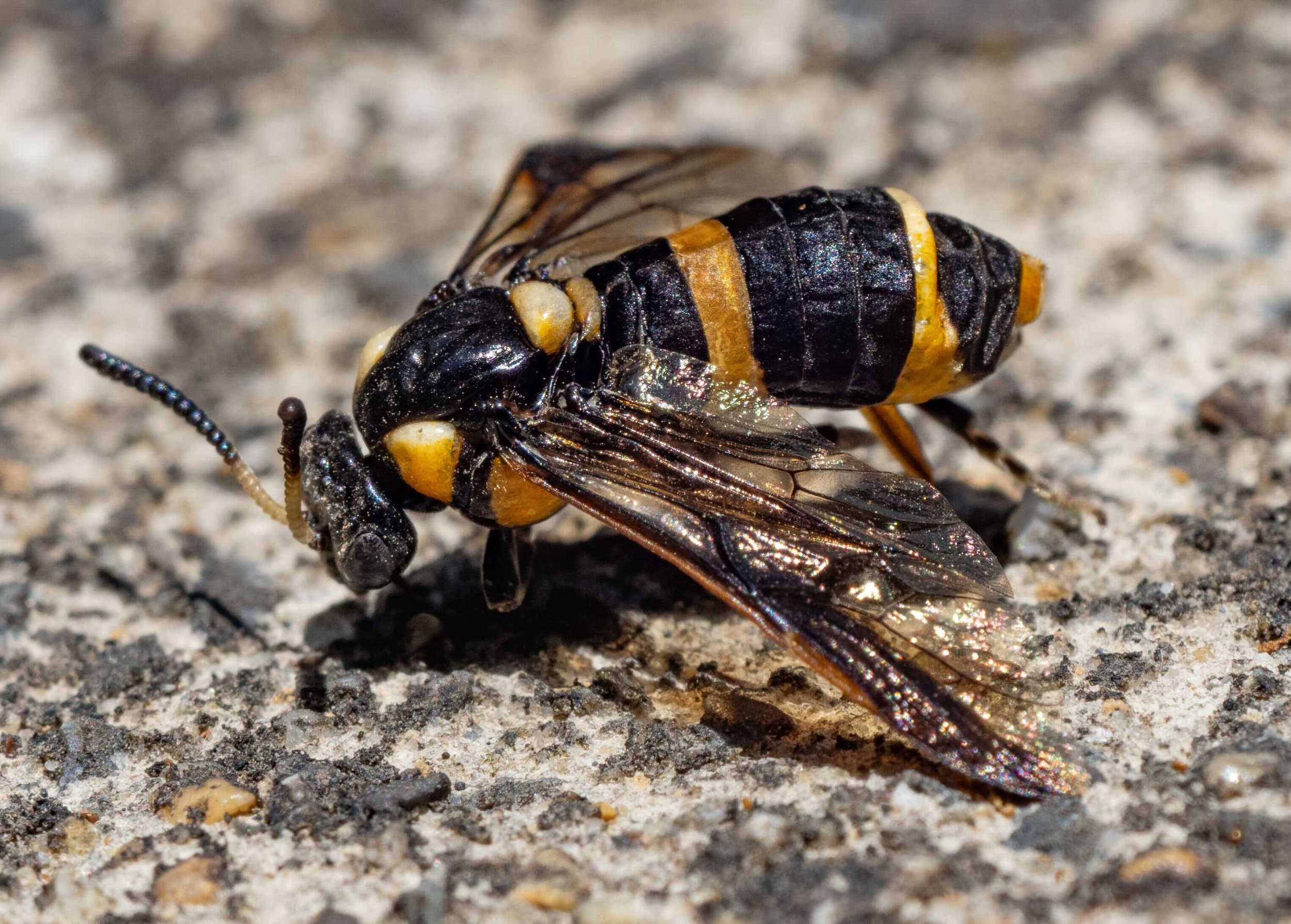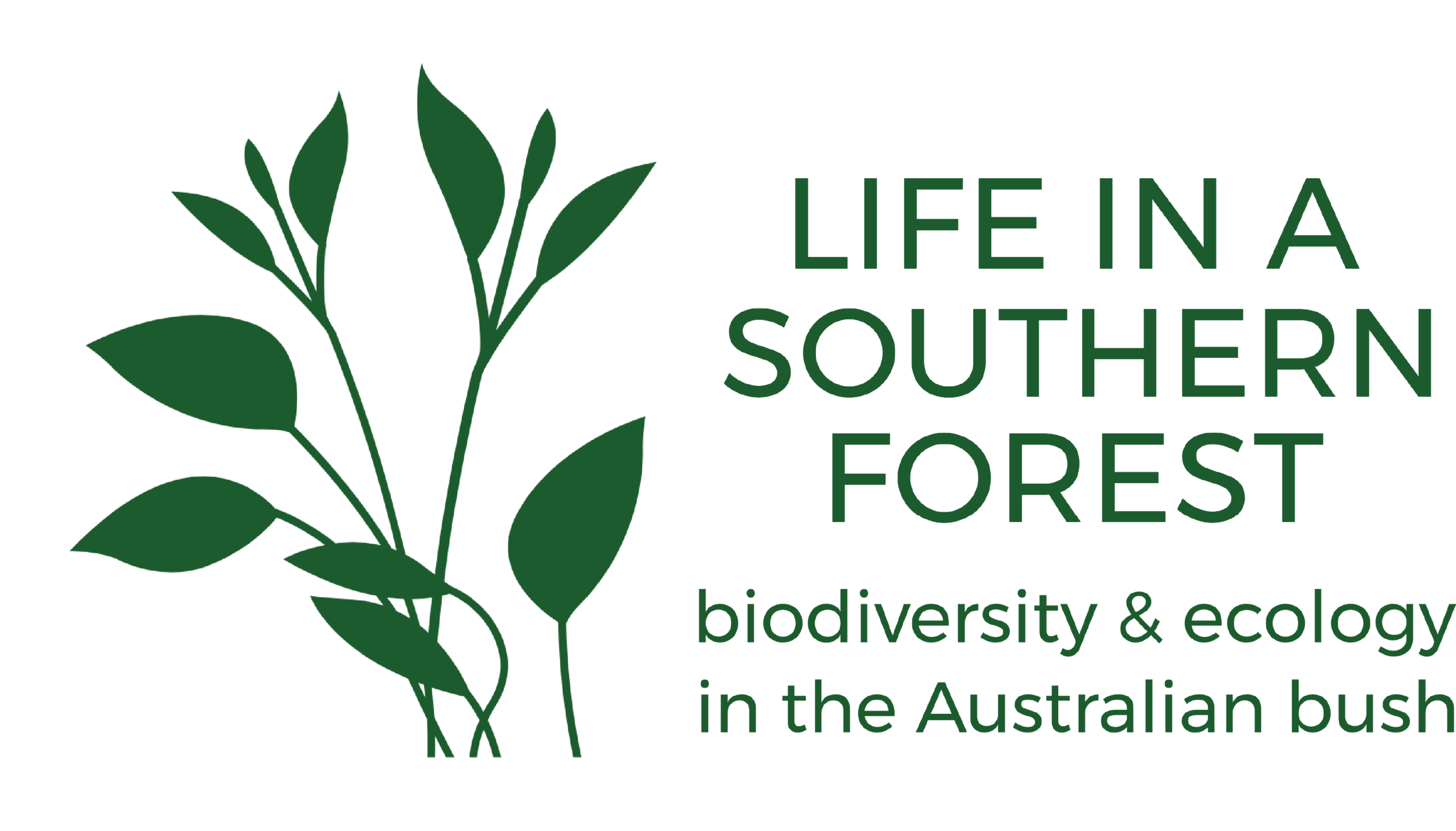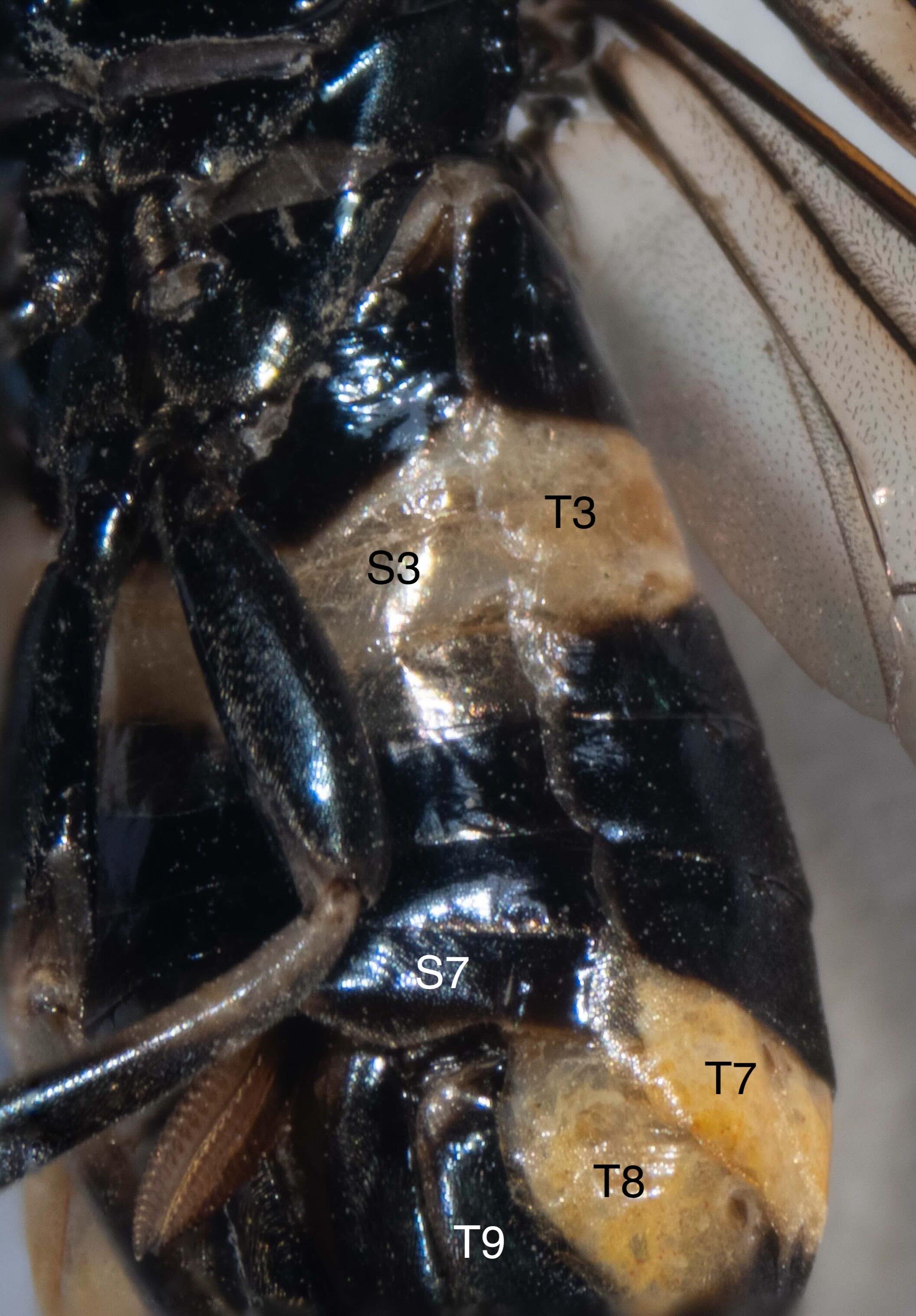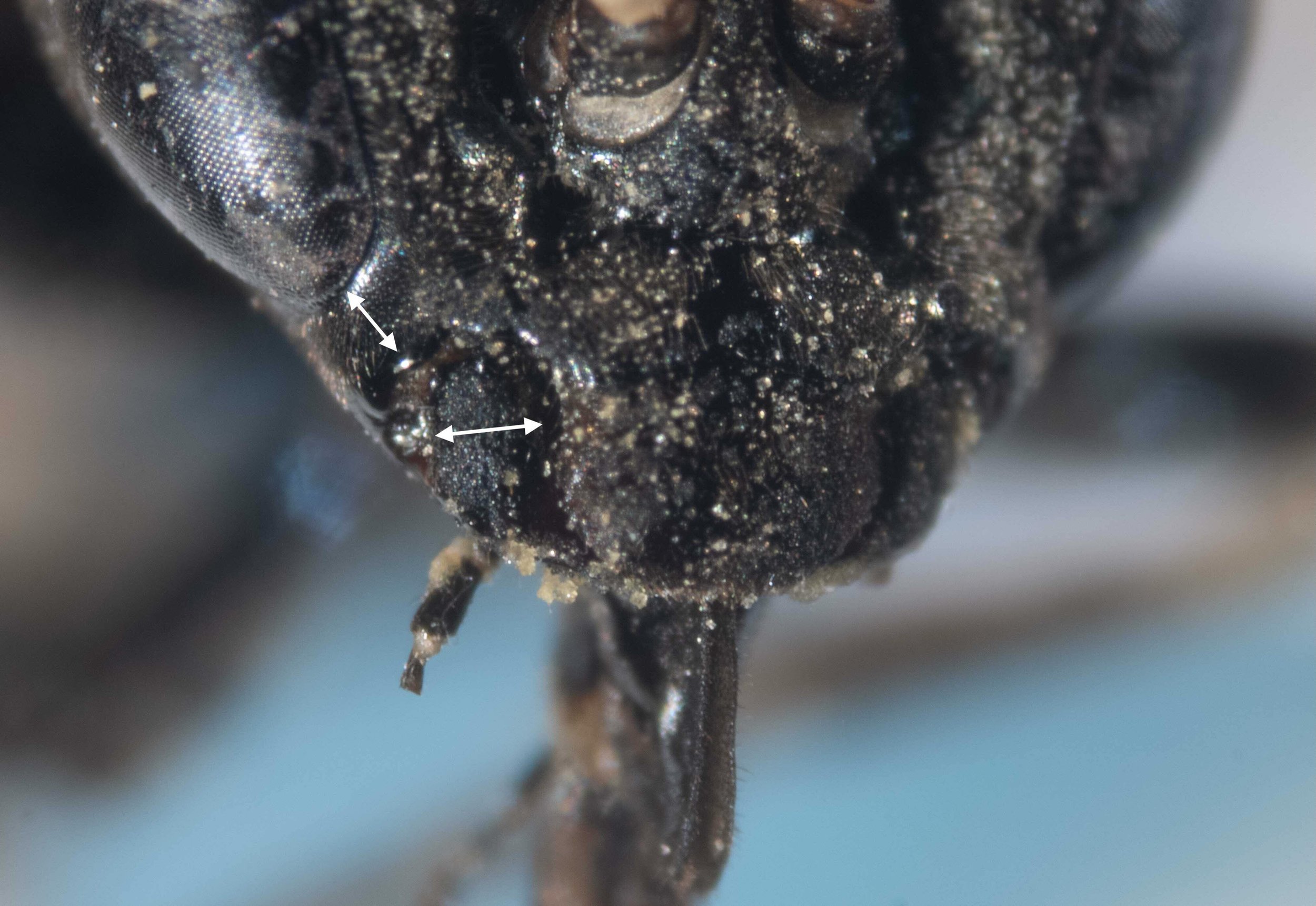Pterygophorus cinctus (PTERYGOPHORINAE) PW036

Workbook
Dead female sawfly found on 4th December at Bellingen, NSW (PW036), providing an opportunity for a detailed examination of its morphology.
I hoped this might help determine whether there are characters that could be used to separate the 4 similar Pterygophorus spp. - P. cincus, P. distinctus, P. insignis and P. facielongus - in photographs.
I looked for diagnostic features of these species in original descriptions - as listed in this matrix.
Images of characters potentially useful for species identification
Images of wings and legs follow
Does this individual match the descriptions in the literature of female Pterygophorus cinctus?
Body size: length 13mm - Benson (1938) reports 11-14mm
Antenna colour and morphology:
scape black, pedicel yellowish-brown, 8 basal flagellomeres yellow, 13 apical flagellomeres dark brown/black, most apical flagellomere clubbed; pecten gradually increases in size basally to apically - matches drawings by Leach (1817), Konow (1905), Schmidt photo.
agrees with Benson Pterygophorus description = 0.4x forewing - Konow 0.34, Leach 0.37
Head morphology:
black
eyes converge in front so distance between them equal to greatest eye length - agrees with Benson Pterygophorus description and drawing
breadth of clypeus = 2/3 length of eye - agrees with Benson Pterygophorus description
malar space = 0.42 breadth of mandible base - Benson <0.5
apex of clypeus emarginate - agrees with Benson, Morice (1919)
antennal furrow present
pubescence short, fine and pale over whole head
smooth and shining with no punctures
labium subequal to greatest breadth of clypeus - Benson gives figure of 1.5X but this does not match his drawing of P. cinctus, which shows them to be subequal
ligula same length as 3 basal segments of labial palp - agrees with Benson drawing of P. cinctus
Thorax morphology:
pronotum yellow with black anterior border and black posterior border from accessory furrow; accessory furrow subparallel with posterior margin of pronotum; side portion cut off by accessory furrow as broad as malar space; covered in short, fine, pale pubescence - agrees with Benson description of Pterygophorus and description/drawing of P. cinctus
mesepisternum black with large central yellowish-orange patch, covered in short, fine, pale pubescence
mesoscutum black, shining, sparse/no? punctures, sparse pubescence
mesoscutellum & metascutellum shining, pale yellow, without punctures or pubescence
thorax morphology and colouration agrees with all previous descriptions/drawings/photos of P. cinctus by Leach, Konow, Benson, Schmidt
Abdomen morphology:
black with 2 yellow bands
anterior band forms complete band around the abdomen, confined to borders of T3 dorsally but crosses into anterior region of T4 laterally and ventrally
posterior band on a narrow bulge on T7 just posterior to its border. The yellow band extends ventrally, expanding to the posterior border of T7 and crossing into T8 in the latero-ventral region of the abdomen. The yellow band reaches the ventral border of T7 and T8.
pygidium (T10) is also yellow
abdomen colouration agrees with all previous descriptions/drawings/photos of P. cinctus. However, those other sources show the anterior yellow band crossing anteriorly into posterior region T2 and posteriorly into T4 more extensively than seen in the current specimen. This appears to be a variable feature.
saw morphology - tooth #10 has 43 denticulations, close to the range of 28-40 reported by Benson and with a similar morphology
Forewing morphology:
hyaline with a dark brown infuscation extending along the anterior border to the wing apex, covering 1st discoidal, 1st cubital and radial cells completely and half of 2nd and 3rd cubital cells
costa and stigma yellowish-brown
venation blackish-brown
wing morphology agrees closely with all previous descriptions and drawings
Leg morphology and colouration:
coxa, trochanter and femur black in all legs
tibia - all legs black except for whitish-yellow on ventral side of basal half
tarsi - all legs black except for whitish-yellow on dorsal side of basal third of all tarsomeres
hind basitarsus same length as following tarsomere
Conclusion: This specimen is a close match to previous descriptions of Pterygophorus cinctus. The only feature that differs is the extent of the anterior yellow band on the abdomen, which varies in other descriptions of this species.
What characters can be used to separate Pterygophorus cinctus from the other 4 Pterygophorus spp.?
Pterygophorus turneri
North Queensland species
Differences to Pterygophorus cinctus - based on descriptions by Benson (1938) and Rohwer (1910)
Head & thorax: malar space relatively long; mesepisternum all black, lacking yellow patch
Abdomen: fully black without yellow bands on segments 3 and 7. However, Schmidt BOLD specimen has a yellow band on anterior half of T7, as do females, but not males, in all iNaturalist observations
Legs: same colouration, but hind basitarsus 1.5x as long as next tarsal segment
Conclusion: Clear differences in colouration of thorax and abdomen should make it straightforward to distinguish P. turneri from P. cinctus in photographs
Pterygophorus distinctus
NSW species
Differences to Pterygophorus cinctus - based on descriptions by Benson (1938), Rohwer (1910) and Morice (1919)
Head: clypeus truncate, rather than emarginate. Head opaque with close punctures.
Abdomen: Rohwer claims that segments 1 & 2 and part of 6 are yellow. However, Benson and Morice (1919) state that colouration is the same as P. cinctus.
Conclusion: Differences in colouration of abdomen should make it possible to distinguish P. turneri from P. cinctus in photographs. However, it is not clear whether these differences actually exist. All descriptions are based solely on the holotype in BMNH.
Pterygophorus insignis
North Queensland to northern NSW species
Differences to Pterygophorus cinctus - based on descriptions by Kirby (1894), Morice (1919), Benson (1938).
Note that Purcell and Goolsby (2005) state that Ian Naumann and Stefan Schmidt identified Pterygophorus insignis adults. They say that P. insignis has gold bands on abdominal segments 2-5 and gold markings on segment 7. Stefan Schmidt also submitted a specimen of P. insignis to BOLD, which he identified from its morphology (PERGI1041-12).
Head: malar space very long
Abdomen: yellow bands on segments 2 & 3, sometimes spreading onto segment 4. yellow band on segment 7 which spreads round to include T8 and hypopygium
Forewing: Kirby reports a “smoky bar extending below the outer 2/3rds to tip”. It is unclear whether this corresponds to the dark brown infuscation in P. cinctus.
Legs: hind tibia and tarsi entirely yellow
Conclusion: Apparently consistent presence of yellow band on all or most of abdominal segment 2 and entirely yellow colour of hind tibia and tarsi provide strong support for P. insignis being a different species to P. cinctus. The colour differences on the abdomen and legs should make it straightforward to separate these species in photographs.
Pterygophorus facielongus
Victoria to south Queensland (4 type specimens in Melbourne Museum)
Differences to Pterygophorus cinctus - based on description by Benson (1938).
Body size: 13-16mm would make it somewhat larger than P. cinctus
Abdomen: similar to P. insignis - yellow band mostly confined to segment 3 but spreading in part onto segments 2 and 4. conspicuous bulge on T7, spreading onto sides of T8. However, Benson states hypopygium black rather than yellow.
Saw: 10th tooth has about 50 vs. 28-40 denticulations for P. cinctus (Benson)
Legs: tibiae black with basal 1/3 of ventral side yellow; tarsi black with dorsal side and base yellow/brownish. same as P. cinctus but differs from P. insignis
Conclusion: Body size, saw morphology and consistent yellow colour of at least part of T2 as well as black colour of hypopygium support P. facielongus being a different species to P. cinctus. However, only the yellow band on T2 and the black hypopygium would be useful features for species separation in photographs, particularly because this species overlaps geographically with P. cinctus.
This is a workbook page … a part of our website where we record the observations and references used in making species identifications. The notes will not necessarily be complete. They are a record for our own use, but we are happy to share this information with others.



































